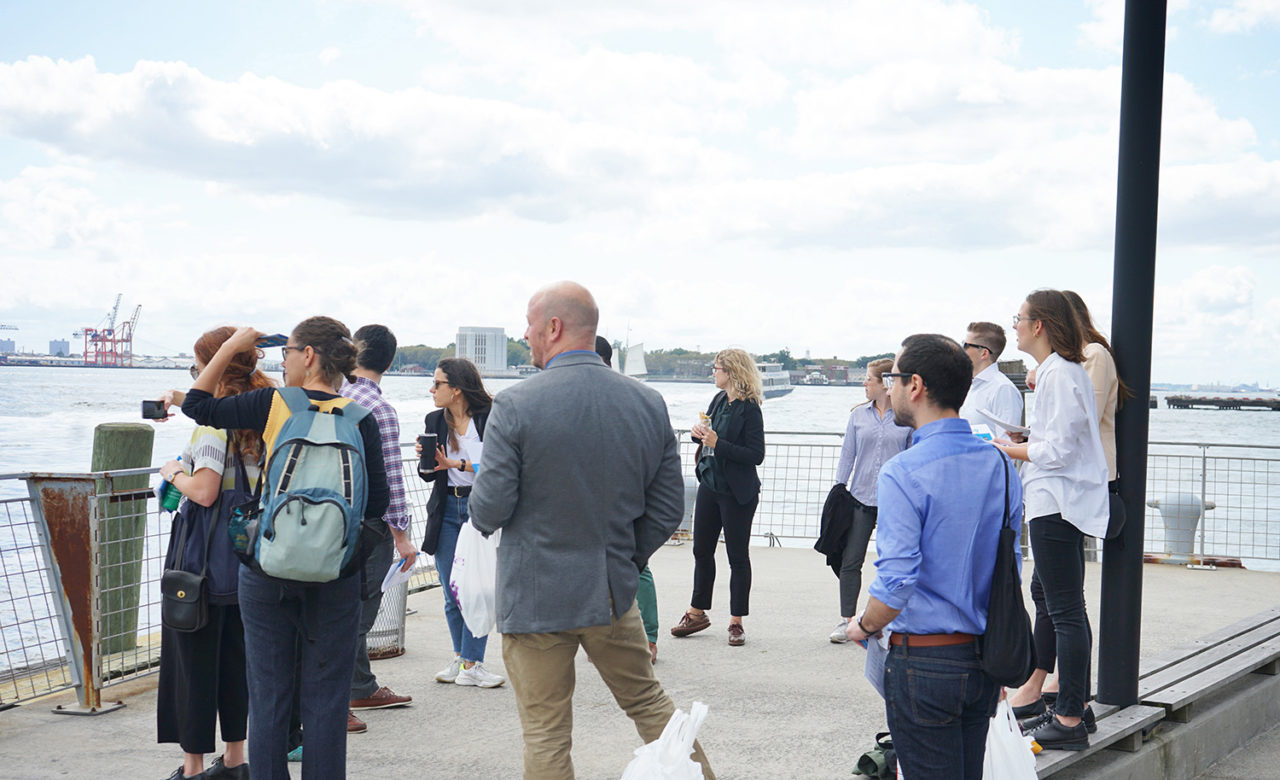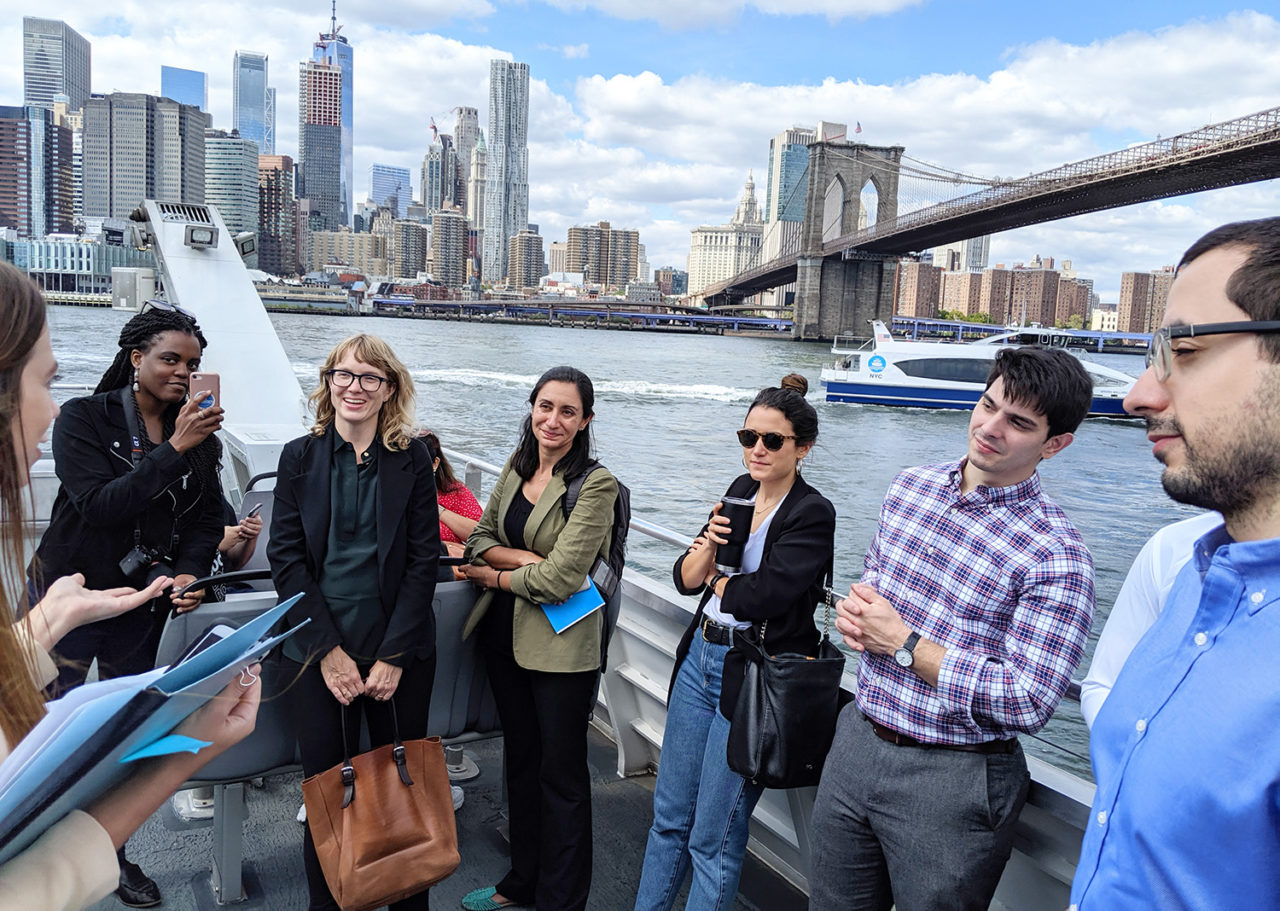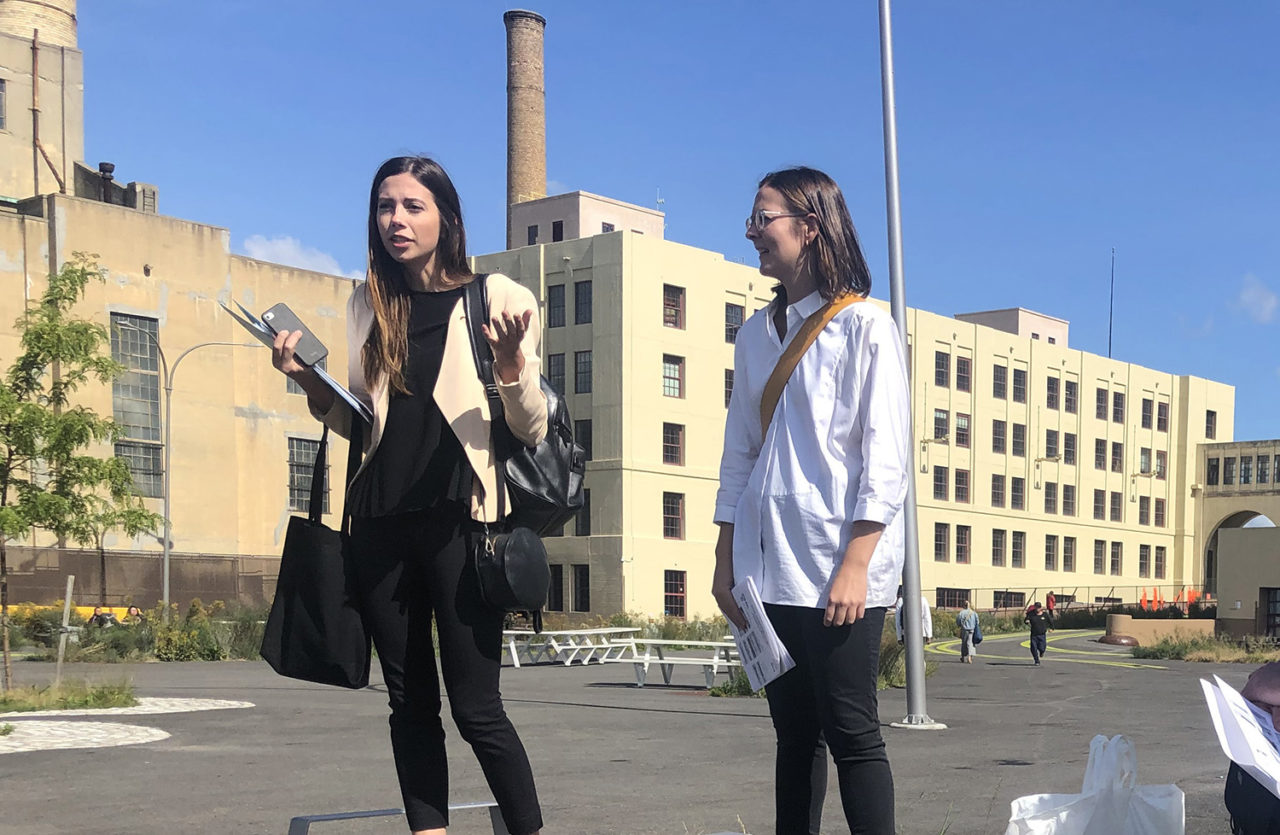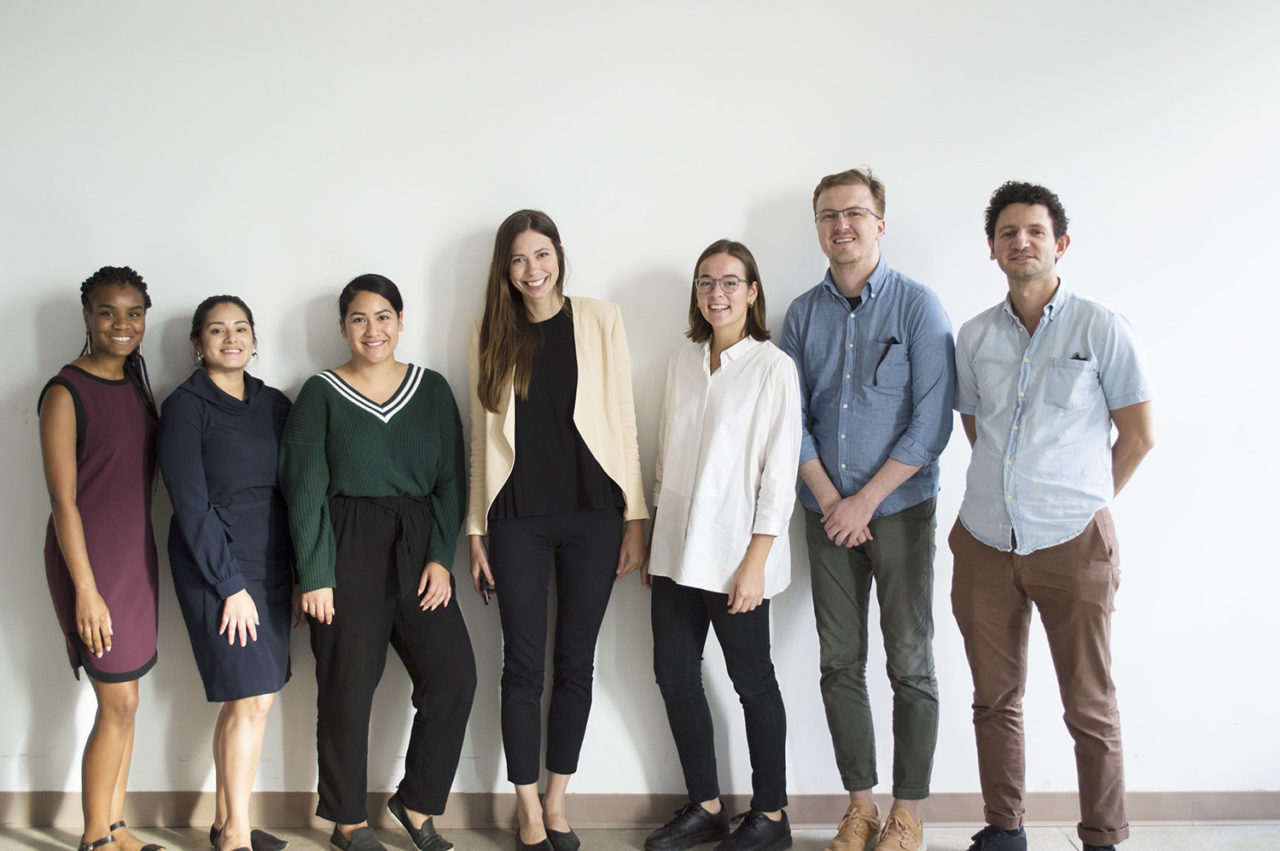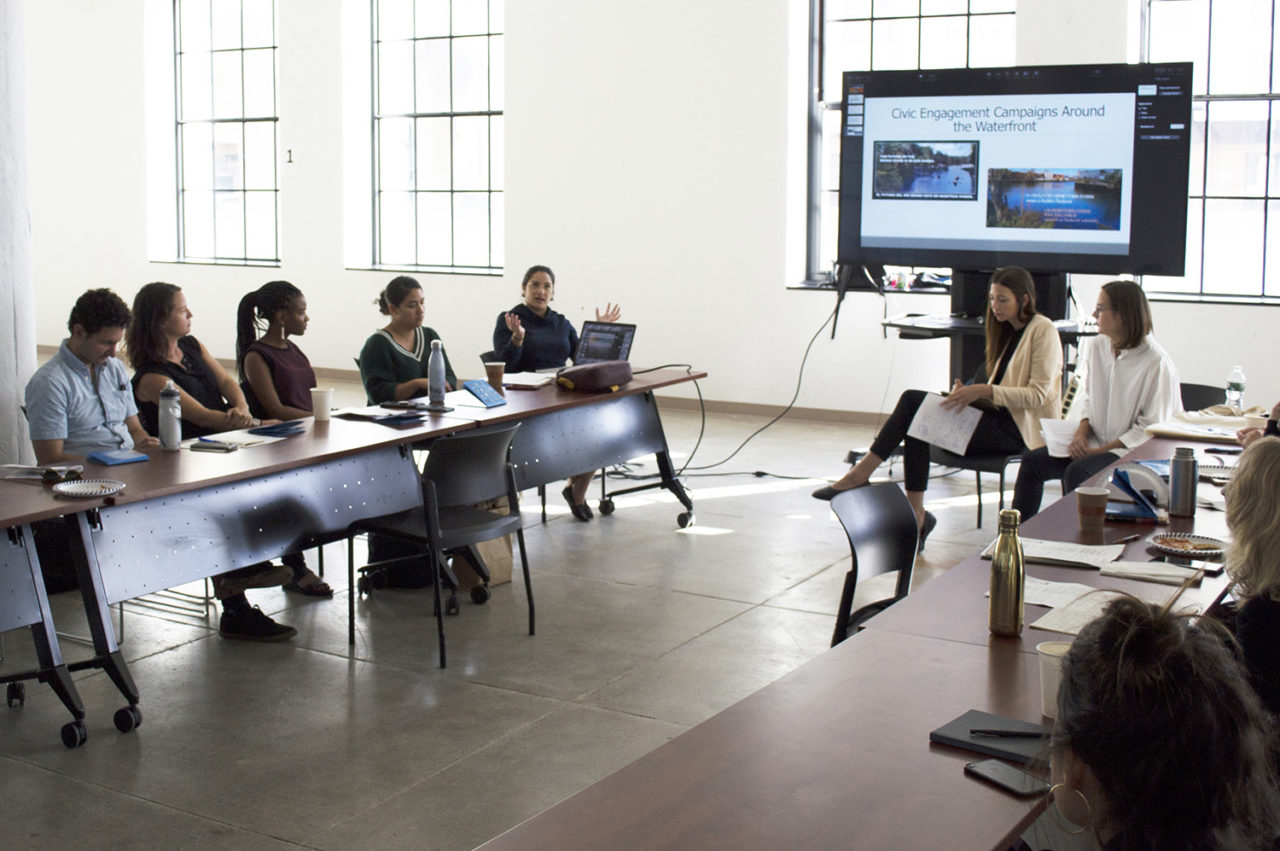by: Athena Unroe and Casie Kowalski
Architects are giving increased attention to the important concept of social equity as they work to define their role as stewards of public welfare—and authors of thoughtful design around it. In the greater New York City area, social equity addresses many complex issues at the waterfront, ranging from coastal resiliency to environmental justice and even extending to the accessibility of public programming, infrastructure, and public policy. On Friday, September 13, the AIANY Civic Leadership Program (CLP) Class of 2019 convened for its fourth development session to explore these forms of social equity within New York City’s developing waterfront and its neighborhoods. The session began at the Pier 11/Wallstreet Ferry Terminal, allowing the CLP participants to see the many adjacent scales and functions of the waterfront, ranging from private development to Significant Maritime Industrial Areas (SMIAs). Following a ferry ride, the group gathered at Brooklyn Army Terminal in Sunset Park to discuss aspects of waterfront equity.
Organized and led by CLP members Athena Unroe and Casie Kowalski, the program hosted five panelists who work in waterfront planning, research, policy, development, and community engagement:
- Allan Zaretsky, Senior Planner for NYC Department of City Planning’s (DCP) Water and Open Space Planning unit;
- Megan Quirk, Assistant Vice President in the Ports and Transportation division of the NYC Economic Development Corporation (EDC);
- Elizabeth Balladares, NYNJ Harbor Estuary Program Urban Waters Ambassador for the lower Passaic River;
- Jalisa Gilmore, Research Analyst at the NYC Environmental Justice Alliance (EJA); and
- Adriana Espinoza, New York City Program Director at New York League of Conservation Voters (NYLCV).
Prior to the development session, Unroe and Kowalski spoke to multiple shoreline stakeholders, including private entities (Industry City), non-profit organizations (ALIGN and Brooklyn Navy Yard), and landscape designers (Susannah Drake of DLAND Studio), along with New York City public agencies (DCP and EDC), among many others. Through these meetings, the CLP leaders learned that mixed interests among waterfront stakeholders make it difficult to balance today’s need for increased public access to the waterfront with the expansion of waterfront trade, industrial growth, and transportation in SMIAs. While this is a design-related issue, could architects have more agency—prior to design—through funding, policy forums, public programming, and pilot projects?
One example of a pre-design engagement tools is the Waterfront Alliance’s WEDG Program. Sarah Dougherty, program manager at the Waterfront Alliance, notes that in terms of accountability, “WEDG is building a grassroots movement for Community Boards and communities to hold waterfront projects accountable, using the program as a powerful tool and framework to accomplish better outcomes for waterfront resilience, ecology, and access.” Resources like those developed by the Waterfront Alliance and other climate-focused organizations are easy and accessible public toolkits for architects to consider early on in the process of design and planning.
Another example from the New York League of Conservation Voters centers on active participation, with Adriana Espinoza noting that “reminding people of the importance of the role of the built environment is a unique and critical role [that] architects play. Designers and architects could be involved in policy forums through attendance, since they are open to the public, along with bringing in their own knowledge base of the built environment with recommendations.”
As Lucretia Montemayor, an urban planner from the NYC Department of City Planning (DCP), noted early in our research, “Our relationship with water has been changing over the last twenty years. In some sense there is more interest in the water, we’re more aware and there is more development. At the same time, you could be anywhere in NYC and disconnected from the waterfront, even though we are never more than two and a half miles away from a body of water in NYC.”
At Brooklyn Army Terminal, guest speakers outlined the relationships between shoreline stakeholders and communities, sharing resources from city agencies and non-profit organizations that citizen architects can use as pre-design tools to center the conversation on the pros and cons of waterfront development and how such projects can impact public welfare.
DCP’s current Waterfront Comprehensive Plan, presented by Senior Waterfront Planner Allan Zaretsky, is a regional strategy that outlines land use along the waterfront. The plan was released in 2011, and according to DCP’s site, “set the stage for expanded use of our waterfront for parks, housing and economic development, and of our waterways for transportation, recreation and natural habitats.” The plan incentivized expanding citywide ferry service, the development of new waterfront parks and greenways, rezoning of waterfront areas, and the creation of resiliency studies. DCP’s updated plan will focus on resiliency, equity, and health, while continuing to tackle major waterfront issues such as aging public and private shoreline infrastructure, improving maritime industry/trade, and water transportation.
The NYC Economic Development Corporation (EDC), represented by Assistant Vice President in the Ports and Transportation division Megan Quirk, operates and manages the NYC Ferry Line project, with plans for future expansion with new ferry routes in 2020 and 2021. EDC has unique methods of public engagement, which include allowing local students to name ferries and maintaining accessibility, ensuring that ferries are an equitable form of transportation at the same cost as the MTA.
The Hudson River Foundation’s NY-NJ Harbor and Estuary Program (HEP), presented by Elizabeth Balladares, looks at the waterfront at a regional scale, centering on engagement, education, and public access to manage the harbor estuary, our “biggest public resource” in the “nation’s largest and most densely developed metropolitan area”. A unique component of HEP is their methodology for measuring the effectiveness of their outreach at a more localized scale—after public events, community members are asked how often they engage with the waterfront.
The NYC Environmental Justice Alliance’s (NYC-EJA) initiatives and resources, shared by Research Analyst Jalisa Gilmore, demonstrate the agency of community and the importance of understanding climate racism and its effects on waterfront adjacent neighborhoods and local businesses. Focusing on several case studies in the automotive repair industry in the South Bronx and South Brooklyn, Gilmore emphasized how critical it is to address the storing of hazardous chemicals in the event of environmental crisis, with communities of color disproportionately affected by these environmental issues.
From a policy perspective, New York League of Conservation Voters’ (NYLCV) City Council Environmental Scorecard holds legislators accountable for their actions on environmental policies. Citing the usefulness of developing green standards in architecture, NYC Program Director Adriana Espinoza provided an opening for viewing the architect as a policy-adjacent participant in climate conversations.
Overall, in seeking to understand the role of the architect in these waterfront-focused conversations, it became evident that redundancy in research and outreach can be beneficial in reaching many communities. Architects and designers often assume the role of problem solvers, but in a context as complex and sensitive as the waterfront, what other roles can we take to actively participate? Only by acknowledging the important work of advocates, agencies, and policy makers can we begin to engage in these regional issues at multiple scales and make meaningful and informed contributions to the communities we design for.








